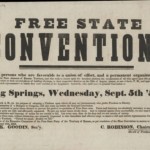A haven for free blacks and runaway slaves by the mid-nineteenth century, Indiana almost legalized slavery at an earlier moment in its history.
After the British took control of the future state of Indiana in 1763, the French residents of Vincennes were allowed to keep their slaves.
Although they lived in bondage, Indiana’s slaves did retain the few limited rights afforded them through the French “code noir”. Slaves could appear in court; families were kept together; and many were baptized and married in the Catholic Church.
When Indiana became part of the United States, the territory came under the governance of the Ordinance of 1787, whose sixth article outlawed slavery.
With no cheap labor, however, many in the territory thought slavery necessary.
Governor William Henry Harrison created a political party based on, among other things, legalizing slavery in Indiana. The party attracted immigrants from Virginia and Kentucky.
Harrison’s party repeatedly petitioned Congress for a ten-year suspension of Article VI, arguing that slavery was necessary for Indiana’s settlement and economic viability. Congress granted the petition, giving territorial legislatures the power to make their own decisions regarding slavery. Under this provision, slaves could be brought into the territory, and their descendants would remain slaves.
Late in 1805, however, thanks to party infighting over the creation of Illinois, the territorial legislature voted down the legalization of slavery.
The anti-slavery contingent, peopled with new immigrants from the north as well as poor southerners, gained ground. Harrison ceded control to an opposition party led by Jonathan Jennings in 1809, when Illinois became an entity distinct from Indiana.
In 1816 Jennings became the first governor of the state of Indiana, whose constitution permanently outlawed slavery.
Within four years, an Indiana Supreme Court ruling freed the state’s remaining slaves.
This essay was drawn from the following source:
Cayton, Andrew R.L. Frontier Indiana. Bloomington and Indianapolis: Indiana UP, 1996.






















